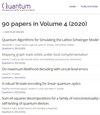Classical Benchmarks for Variational Quantum Eigensolver Simulations of the Hubbard Model
IF 5.1
2区 物理与天体物理
Q1 PHYSICS, MULTIDISCIPLINARY
引用次数: 0
Abstract
Simulating the Hubbard model is of great interest to a wide range of applications within condensed matter physics, however its solution on classical computers remains challenging in dimensions larger than one. The relative simplicity of this model, embodied by the sparseness of the Hamiltonian matrix, allows for its efficient implementation on quantum computers, and for its approximate solution using variational algorithms such as the variational quantum eigensolver. While these algorithms have been shown to reproduce the qualitative features of the Hubbard model, their quantitative accuracy in terms of producing true ground state energies and other properties, and the dependence of this accuracy on the system size and interaction strength, the choice of variational ansatz, and the degree of spatial inhomogeneity in the model, remains unknown. Here we present a rigorous classical benchmarking study, demonstrating the potential impact of these factors on the accuracy of the variational solution of the Hubbard model on quantum hardware, for systems with up to $32$ qubits. We find that even when using the most accurate wavefunction ansätze for the Hubbard model, the error in its ground state energy and wavefunction plateaus for larger lattices, while stronger electronic correlations magnify this issue. Concurrently, spatially inhomogeneous parameters and the presence of off-site Coulomb interactions only have a small effect on the accuracy of the computed ground state energies. Our study highlights the capabilities and limitations of current approaches for solving the Hubbard model on quantum hardware, and we discuss potential future avenues of research.哈伯德模型变分量子特征解算器模拟的经典基准
模拟哈伯德模型对凝聚态物理的广泛应用具有很大的兴趣,但是在大于1的维度上,其在经典计算机上的解决方案仍然具有挑战性。该模型的相对简单性,体现在哈密顿矩阵的稀疏性上,允许其在量子计算机上有效实现,并使用变分算法(如变分量子特征求解器)进行近似求解。虽然这些算法已被证明可以再现哈伯德模型的定性特征,但它们在产生真实基态能量和其他属性方面的定量精度,以及这种精度对系统大小和相互作用强度、变分分析的选择以及模型中空间非均匀性程度的依赖,仍然未知。在这里,我们提出了一个严格的经典基准研究,展示了这些因素对量子硬件上哈伯德模型变分解的准确性的潜在影响,对于具有高达32美元量子比特的系统。我们发现,即使在Hubbard模型中使用最精确的波函数ansätze,其基态能量和波函数平台的误差对于较大的晶格,而更强的电子相关性放大了这个问题。同时,空间非均匀参数和场外库仑相互作用的存在对计算基态能量的精度影响很小。我们的研究强调了当前解决量子硬件哈伯德模型的方法的能力和局限性,并讨论了潜在的未来研究途径。
本文章由计算机程序翻译,如有差异,请以英文原文为准。
求助全文
约1分钟内获得全文
求助全文
来源期刊

Quantum
Physics and Astronomy-Physics and Astronomy (miscellaneous)
CiteScore
9.20
自引率
10.90%
发文量
241
审稿时长
16 weeks
期刊介绍:
Quantum is an open-access peer-reviewed journal for quantum science and related fields. Quantum is non-profit and community-run: an effort by researchers and for researchers to make science more open and publishing more transparent and efficient.
 求助内容:
求助内容: 应助结果提醒方式:
应助结果提醒方式:


